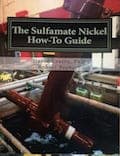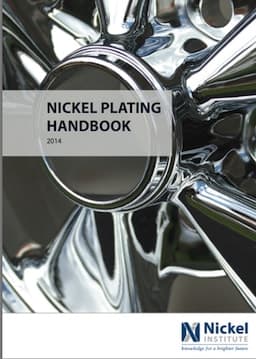
-----
Nickel plating peeling problem
Q. Hello everyone, My name is Christian I am 23 years old and besides working for an electroplating company I am also a big fan of it. In the last few months we have some problems with the nickel plating of our parts. in some tanks where we produce, our parts come out with problems that I list below:
- Bubbles (not those caused by hydrogen) could it be that the deposit is too compressed?
- Hydrogen bubbles.
- But the most serious thing is that so many of our "customers" parts produced in these tanks come back because the deposit comes off completely the first time the tool is used -- both nickel on nickel and steel on nickel. In recent months we have tried numerous changes:
Then, we use Watts baths with added additives (SNAP and PC4).
Snap is used to decrease the surface tension of the bath and make our parts "wet", while PC4 is used as a deposit detensioner. we keep pH, temperature, and density under control, filter the activated carbon baths every 4 months.
Does anyone have any idea where these problems come from?
(translated with www.DeepL.com/Translator -- free version)
Regards
- Pietracuta, Italy
September 7, 2023
A. Hi Christian,
I hope we're not mis-translating, but I think when you say "bubbles" you are speaking of "blisters" --very similar to skin blisters or blood blisters?
Although there are usually many possible causes, if you lack adhesion in nickel plating it is often because of intermittent or broken contact. Are you doing "rack" plating or "barrel" plating? But, yes, excessive stress can cause peeling as well. Do you plate Hull Cell
⇦ huh?
panels, and if so, what do they tell you? When you say "tool" are you referring to things like pliers and wrenches or what sort of object are you plating?
Luck & Regards,

Ted Mooney, P.E. RET
Striving to live Aloha
finishing.com - Pine Beach, New Jersey
Ted is available for instant help
or longer-term assistance.
|
|
A. Hello, Christian and Ted! - Rio de Janeiro, Brazil Q. Hello Ted, yes the bubbles I describe are likened to a Blistering effect (I am still inexperienced and trying to slowly learn everything). We do not use racks or barrels but dip the parts in tanks used to diamond together with nickel our parts. Our company makes diamond grinding wheels for various applications so each piece is its own piece because it is custom made for the customer. |
Q. Hi pedro,
Sure we had thought about filtering the baths more frequently, but having 37 nickel tanks the operation might be a bit complicated ...
How do you guys go about filtering again? Do you use cartridges with charcoal or do you do it continuously? How long do you filter, and how do you make sure that the filtration has gone well?
Sorry for too many questions....
Regards,
- san leo, Italy
September 14, 2023
A. Hi, Christian!
37 tanks, it is really a big operation! I can't even imagine what it's like controlling the whole process.
Here in the region where I work, the industries normally use a "filter pump". If you google "filter pump electroplating" you'll see what it looks like, but I don't know if it's the best way or even if it's available in Italy.
We try to filter the nickel baths at maximum every other week, otherwise we start seeing white patches in the deposit. Ideally, we don't use the bath when we are filtering it, because the carbon removes the wetting agent and brightener, which causes sudden pitting and decrease in brightness. If we can't stop the operation so as to filter from at least 7am - 12pm, we filter it anyways while working, but must increase the addition of all the additives during the operation.
A good way to verify if it has worked is to do a Hull cell before filtering and another after filtering the solution. If you have excessive additives in your bath, the hull cell will probably not be bright, have white patches, and will maybe blister if you bend the corner of the cell.
Do you have a way to test the adhesion of the deposit during your normal operation, before sending the parts to your client? Here, since we produce thousands of cheap small parts per day, we usually hammer a couple of parts every hour, and the deposit mustn't come off.
Also, have you checked you activation acids?
Hope it helps,
- Rio de Janeiro, Brazil
September 27, 2023
⇩ Related postings, oldest first ⇩
Q. We are barrel plating millions of very small metal pieces monthly. The same semi-bright nickel baths are also used for coating larger components. Our problem is that occasionally the very outmost nickel layer is peeling of in tape test. Also in microscope studies we can see strong layering and sometimes even cracks parallel to the substrate. It looks like the problem only exists in plating specific shapes. The adhesion to the substrate is good though.
Does anybody know why this kind of phenomena can be seen? Inner stresses? Current cuts and passivation? Organic impurities? Barrel movement? Something else?
Please give me an idea how to proceed here. I am beginning to feel a little bit stupid.
plating shop - Finland
2005
? You need to give more details. Pretreatment details, plating chemistry and parameters, type of arrangement and equipment used (barrel only or hang of larger parts).
Guillermo MarrufoMonterrey, NL, Mexico
2005
? Firstly, what kind of material is it? pretreatment, activation of substrate is very important, but is not all.
How are obtained the pieces. Also this depends a lot.
- Arad, Romania
2005
A. If appears you have nickel from nickel flaking. Sometimes the problem is easily fixed, sometimes it requires more investigative procedures. It appears the flaking is caused by something going wrong in the nickel bath. First thing look for something that has changed. I suspect a bipolar electrical condition, make-break contacts, overloaded barrels, defective conductors or buss rails, and don't forget to inspect the danglers inside the barrels.
Larry Brannock- Cana, Virginia
2005
A. Hi Vesa,
I think your barrel loses contact. So you must serve the connection in your barrel.

Anders Sundman
4th Generation Surface Engineering
Consultant - Arvika,
Sweden
2005
A. Please concentrate on Barrel's motor speed, Activation of the parts, anti pit concentration, organic contamination, excess of brighteners/additives.

Shafiuddin A. Mohammed
metal coating shop - Dubai, United Arab Emirates
April 8, 2009
Q, A, or Comment on THIS thread -or- Start a NEW Thread


